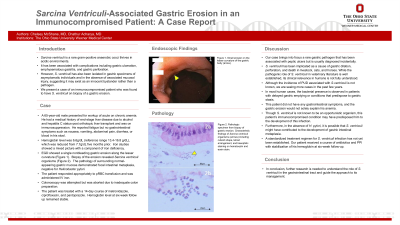Sunday Poster Session
Category: Stomach
P1396 - Sarcina Ventriculi-Associated Gastric Erosion in an Immunocompromised Patient
Sunday, October 22, 2023
3:30 PM - 7:00 PM PT
Location: Exhibit Hall

Has Audio

Chelsey McShane, MD
The Ohio State Wexner Medical Center
Fishers, IN
Presenting Author(s)
Chelsey McShane, MD1, Chathur Acharya, MBBS2
1The Ohio State Wexner Medical Center, Columbus, OH; 2Ohio State University, Columbus, OH
Introduction: Sarcina ventriculi is a rare gram-positive anaerobic cocci that thrives in acidic environments. It has been associated with complications including gastric ulceration, emphysematous gastritis, and gastric perforation. However, S. ventriculi has also been isolated in gastric specimens of asymptomatic individuals and in the absence of associated mucosal injury, suggesting it may exist as an innocent bystander rather than a pathogen. We present a case of an immunocompromised patient who was found to have S. ventriculi on biopsy of a gastric erosion.
Case Description/Methods: A 65-year-old male presented for workup of acute on chronic anemia. He had a medical history of orthotopic liver transplant and was on immunosuppression. He reported symptoms of fatigue but no abdominal symptoms. EGD showed a single nonbleeding gastric erosion along the lesser curvature (Figure 1). Biopsy of the erosion revealed S. ventriculi organisms (Figure 2). The pathology of surrounding normal-appearing gastric mucosa demonstrated focal intestinal metaplasia, negative for Helicobacter pylori. The patient was treated with a course of metronidazole, ciprofloxacin, and pantoprazole. Hemoglobin level six weeks later remained stable.
Discussion: Our case brings into focus a rare gastric pathogen that has been associated with peptic ulcer disease that most clinicians are not aware of and which is usually diagnosed incidentally. While the true incidence of PUD associated with S.ventriculi is not known, we are seeing more case reports in the past few years. This patient did not have any abdominal symptoms and the erosion would not solely explain his anemia. Though S. ventriculi is not known to be an opportunistic organism, this patient’s immunocompromised condition may have predisposed him to the development of this infection. Furthermore, in the absence of H.Pylori, it is possible that S. ventriculi might have contributed to the development of gastric intestinal metaplasia. A standardized treatment regimen for S. ventriculi infection has not yet been established. Our patient received a course of antibiotics and PPI with stabilization of his hemoglobin at six-week follow-up. In conclusion, further research is needed to understand the role of S. ventriculi in the gastrointestinal tract and guide the approach to its management.

Disclosures:
Chelsey McShane, MD1, Chathur Acharya, MBBS2. P1396 - Sarcina Ventriculi-Associated Gastric Erosion in an Immunocompromised Patient, ACG 2023 Annual Scientific Meeting Abstracts. Vancouver, BC, Canada: American College of Gastroenterology.
1The Ohio State Wexner Medical Center, Columbus, OH; 2Ohio State University, Columbus, OH
Introduction: Sarcina ventriculi is a rare gram-positive anaerobic cocci that thrives in acidic environments. It has been associated with complications including gastric ulceration, emphysematous gastritis, and gastric perforation. However, S. ventriculi has also been isolated in gastric specimens of asymptomatic individuals and in the absence of associated mucosal injury, suggesting it may exist as an innocent bystander rather than a pathogen. We present a case of an immunocompromised patient who was found to have S. ventriculi on biopsy of a gastric erosion.
Case Description/Methods: A 65-year-old male presented for workup of acute on chronic anemia. He had a medical history of orthotopic liver transplant and was on immunosuppression. He reported symptoms of fatigue but no abdominal symptoms. EGD showed a single nonbleeding gastric erosion along the lesser curvature (Figure 1). Biopsy of the erosion revealed S. ventriculi organisms (Figure 2). The pathology of surrounding normal-appearing gastric mucosa demonstrated focal intestinal metaplasia, negative for Helicobacter pylori. The patient was treated with a course of metronidazole, ciprofloxacin, and pantoprazole. Hemoglobin level six weeks later remained stable.
Discussion: Our case brings into focus a rare gastric pathogen that has been associated with peptic ulcer disease that most clinicians are not aware of and which is usually diagnosed incidentally. While the true incidence of PUD associated with S.ventriculi is not known, we are seeing more case reports in the past few years. This patient did not have any abdominal symptoms and the erosion would not solely explain his anemia. Though S. ventriculi is not known to be an opportunistic organism, this patient’s immunocompromised condition may have predisposed him to the development of this infection. Furthermore, in the absence of H.Pylori, it is possible that S. ventriculi might have contributed to the development of gastric intestinal metaplasia. A standardized treatment regimen for S. ventriculi infection has not yet been established. Our patient received a course of antibiotics and PPI with stabilization of his hemoglobin at six-week follow-up. In conclusion, further research is needed to understand the role of S. ventriculi in the gastrointestinal tract and guide the approach to its management.

Figure: Sarcina ventriculi-associated gastric erosion
Disclosures:
Chelsey McShane indicated no relevant financial relationships.
Chathur Acharya indicated no relevant financial relationships.
Chelsey McShane, MD1, Chathur Acharya, MBBS2. P1396 - Sarcina Ventriculi-Associated Gastric Erosion in an Immunocompromised Patient, ACG 2023 Annual Scientific Meeting Abstracts. Vancouver, BC, Canada: American College of Gastroenterology.

